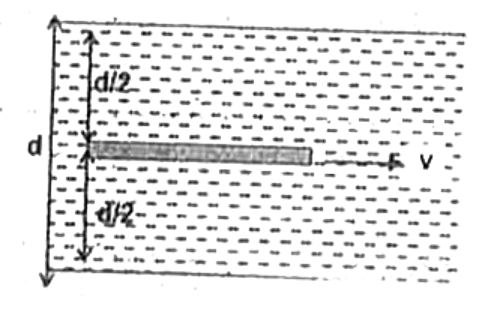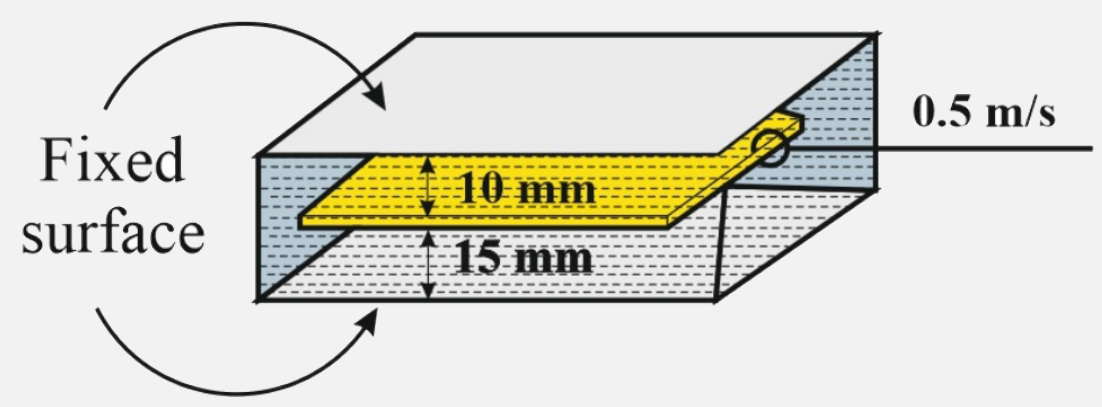A metal plate cm rests on a layer of castor oil 1 mm thick whose coefficient of viscosity is . Find the horizontal foce required to move the plate with a speed of 2 cm/s
To solve the problem of finding the horizontal force required to move a metal plate resting on a layer of castor oil, we will use the formula for viscous force. Here are the steps:
1. Identify Given Values:
- Area of the plate (A) = 5 cm × 5 cm = 25 cm²
- Thickness of the oil layer (dx) = 1 mm = 0.001 m
- Coefficient of viscosity (η) = 1.55 N·s/m²
- Speed of the plate (dv) = 2 cm/s = 0.02 m/s
2. Convert Area to Square Meters:
- Since the area is given in cm², we need to convert it to m²:
A=25cm2=25×10−4m2=0.0025m2
3. Use the Formula for Viscous Force:
- The formula for the viscous force (F) is given by:
F=η⋅A⋅dvdx
- Here, dvdx is the velocity gradient, which can be calculated as:
dvdx=0.02m/s0.001m=20s−1
4. Substitute the Values into the Formula:
- Now, substituting the values into the force equation:
F=1.55N⋅s/m2⋅0.0025m2⋅20s−1
5. Calculate the Force:
- Performing the multiplication:
F=1.55⋅0.0025⋅20=0.0775N
Final Answer:
The horizontal force required to move the plate with a speed of 2 cm/s is 0.0775 N.
- Area of the plate (A) = 5 cm × 5 cm = 25 cm²
- Thickness of the oil layer (dx) = 1 mm = 0.001 m
- Coefficient of viscosity (η) = 1.55 N·s/m²
- Speed of the plate (dv) = 2 cm/s = 0.02 m/s
- Since the area is given in cm², we need to convert it to m²:
A=25cm2=25×10−4m2=0.0025m2
- The formula for the viscous force (F) is given by:
F=η⋅A⋅dvdx
- Here, dvdx is the velocity gradient, which can be calculated as:
dvdx=0.02m/s0.001m=20s−1
- Now, substituting the values into the force equation:
F=1.55N⋅s/m2⋅0.0025m2⋅20s−1
- Performing the multiplication:
F=1.55⋅0.0025⋅20=0.0775N
The horizontal force required to move the plate with a speed of 2 cm/s is 0.0775 N.
Topper's Solved these Questions
- MOTION IN FLUIDS BOOK - ICSECHAPTER - MOTION IN FLUIDS EXERCISE - CONCEPTUAL SHORT ANSWER QUESTIONS WITH ANSWERS
16 Videos
- MOTION IN FLUIDS BOOK - ICSECHAPTER - MOTION IN FLUIDS EXERCISE - LONG ANSWER QUESTIONS
5 Videos
- INTERNAL ENERGY BOOK - ICSECHAPTER - INTERNAL ENERGY EXERCISE - SELECTED PROBLEMS (FROM HEAT ENGINES)
21 Videos
- OSCILLATIONS BOOK - ICSECHAPTER - OSCILLATIONS EXERCISE - SELECTED PROBLEMS (OSCILLATION IN A TUNNEL BORED THROUGH THE EARTH)
2 Videos
Similar Questions
A flat plate of area 0.1m2 is placed on a flat surface and is separated from it by a film of oil 10−5 m thick whose coefficielnt of .viscosity is 1.5Nsm−2 . The force required to cause the plate to slide on the surface at constant speed of 1mms−1is
View SolutionA metal plate 0.04m2 in area is lying on a liquid layer of thickness 10−3m and coefficient of viscosity 140 poise. Calculate the horizontal force needed to move the plate with a speed of 0.040 m/s.
View SolutionA plate of area 100cm2 is placed on the upper surface of castor oil, 2mm thick. Taking the coefficient of viscosity to be 15.5 poise, calculate the horizontal force necessary to move the plate with a velocity 3cms−1.
View SolutionA thin square plate of side φ=10cm is dragged with constant velocity v=3 cm/s in an oil . The width 'd' of the oil column is 2mm. Square plate is placed symmetrically as shown in the figure. Assumed velocity of layer of oil at the end is negligible. The coefficient of viscosity is 150 poise. Find the horizontal force (in Newton) required to move the square plate with constant velocity

View SolutionBetween a plate of area 100cm2 and another plate of area 100m2 there is a 1mm, thick layer of water, if the coefficient of viscosity of water is 0.01 poise, then the force required to move the smaller plate with a velocity 10cms−1 with reference to large plate is
View SolutionThere is a 1mm thick layer of glycerine between a flat plate of area 100cm2 and and a big plate. If te coefficient of viscosity of glycerine is 1.0kg/m−sec, then how much force is required to move the plate with a velocity of 7 cm/sec.
View Solutionflat plate is separated from a large plate by a layer of glycerine of thickness 3×10−3m. If the coefficient of viscosity of glycerine is2Ns/m2 what is the force required to keep the plate moving with a velocity of6×10−2m/s. Area of the plate is 4.8×10−3m
View SolutionGlycerine is filled in 25 mm wide space between two large plane horizontal surfaces. A thin plate of area 0.75m2 at a distance of 10 mm from one of the surfaces is in a horizontal position be the plates inside the glycerine. It is dragged horizontally at a constant speed of 0.5ms2. Take coefficient of viscosity η= 0.5 Ns m−2. What is the force required to drag the plate at a constant speed (in newton) ?

View SolutionA metal square plate of 10cm side rests on 2mm thick caster oil layer. Calculate the horizontal force needed to move the plate with speed 3cms−1:( Coefficient of viscosity of caster oil is 15 poise. )
View SolutionA metal plate of area 103 cm2 rests on a layer o oil 6 mm thick. A tangential force of 10−2 N is appled on it to move it with a constant velocity of 6 cm s−1 . The coefficient of viscosity of the liquid is :-
View Solution
